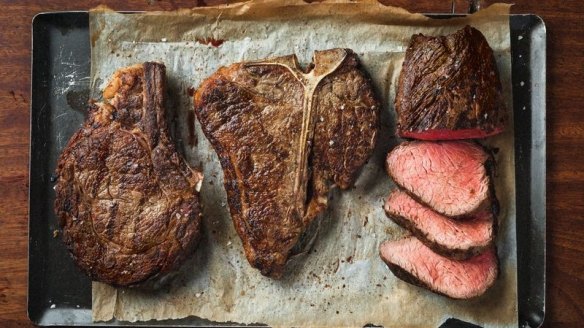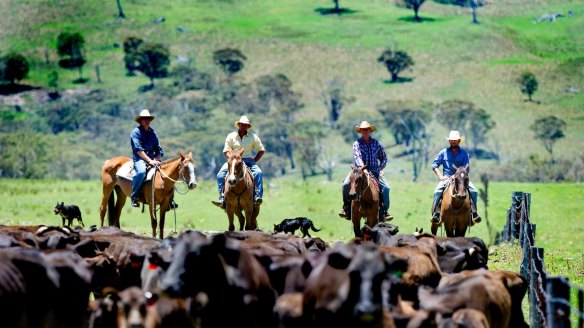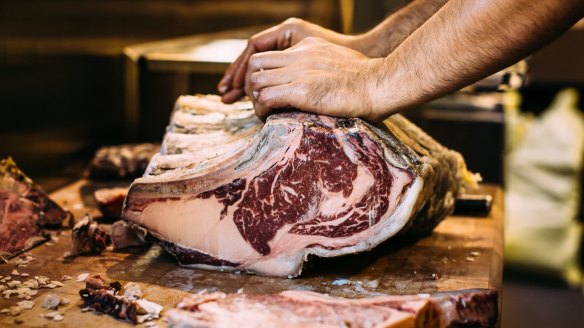In search of the perfect steak

Here's something you may not know. Every summer, London holds the World Steak Challenge. Butchers, producers and farmers from all over the globe turn up to pit their best cuts of meat against each other in a bid for the title of World's Best Steak. Yes, it's a real thing.
The competition is judged by a panel of chefs, food writers and butchers. For the past two years, it's been Tamworth-based wagyu producers Jack's Creek who have taken home the gong. This year for the third time, they won gold for their fillet steak, though the overall prize went to Polish producers F&M Frackowiak. While the competition is still fairly new (2017 was its third year), there's hope this will become the meat equivalent of the World's 50 Best (both are run by business media organisation, William Reed).
It's not the wildest idea that's been floated this year.

As diners, we're consumed with the rare, unusual, niche and boutique. Forget about farm to table. We want the farm on the table. Cuts of meat, their provenance, whether they're dry-or-wet-aged, bone in or bone out, grass-fed or grain have all become as important – if not more – as the butchery the meat came from.
For beef producers, butchers, providores and chefs there's more pressure than ever to create new reasons to keep punters interested. Wet-aging in mineral water, dry-aging beef to the point that it tastes more like cheddar cheese than a steak. Where does the marketing end and the deliciousness begin?
And what makes the perfect steak, really?
"Knowing the animal has been reared in a compassionate, caring way adds to the experience. It gives you a sense of well being. If the animal has had a good life, the quality will come through."
George Abrahams started out as a tea boy, mashing brews for the butchers at Smithfield Meat Market. He's now one of the East London market's most respected butchers and suppliers. Off-duty, his personal preference is for a grass-fed rump, reared as free-ranging as possible. He reckons he can even smell the difference between raw grass-fed and grain-fed meat.
"I like the idea of non corral-fed animals that eat when they want to eat, rather than waiting for someone to come along and shovel stuff into their pen," he says. "Knowing the animal has been reared in a compassionate, caring way adds to the experience. It gives you a sense of well being. If the animal has had a good life, the quality will come through."
The reason he likes rump so much, he says, is the challenge it poses. "It's one of the most difficult cuts to get consistently right. You have to have an animal that is of good stock, that's been cared and reared for, calm and not put under stress. The rump is constantly working hard and it will eat tough if not treated right."
The grass versus grain-fed argument is long and complicated and comes down to personal preference. But there's definitely a sense of romance when it comes to the story of small producers rearing grass-fed cattle. "The ultimate result," says German providore Frank Albers, "is the cow just dies of old age in the field. Even a vegetarian couldn't argue with that."
Albers is what you might call a fixer. If you're after it, chances are he can probably get it for you. During the mad cow epidemic of the '90s, and the price spikes of imported beef that came with it, he supplied Germany's meat lovers with ostrich, snake, emu and crocodile. "The exotic," he says, "became the norm." And while today he sells a lot of prime grain-fed wagyu (he's Jack's Creek's Man in Europe), he also deals in grass-fed meat. Either way, he's looking for the best of the best. When choosing a steak, he's looking for marbling, tenderness and flavour.
Hans Erik Holmqvist, co-owner of Nordic wagyu beef company, Reco Meat, agrees. "The perfect steak is juicy, tender and full of flavour. My absolute favourite at home right now is flank for the texture." He and his business partner Martin Sonefors raise their cows on grass in the traditional Swedish way of small farms, left to graze until they're ready for the chop. Interestingly, Holmqvist was the original chef at Faviken - the tiny restaurant that put Far North Sweden on the fine dining map. In fact, he gave current chef Magnus Nilsson his first job in the kitchen.
For Patrick Warmoll, MD at Jack's Creek, it's all about consistency. "I'm in the flavour business, and a producer of grain-fed beef. The perfect steak for me is a medium marbled piece of beef, lightly seasoned. At the moment my go-to cut is a sirloin, but we've also been eating a lot of rump cap."
That consistency, he says, is achieved that by raising cows in a controlled environment. The family-run business didn't start specialising in wagyu production till the mid-90s. Patrick's father Phillip says while it wasn't a hard decision to make back then, it did mean going without an income for three years, making the changeover. Even from the beginning, you're battling the numbers - 200 days initially in the feedlot is a bare minimum. 450 days is optimum for softer meat, because the animal has been sedentary longer. That's a long time between steaks.
Today, the family export the majority of their meat to Japan and Saudi Arabia, as well as the UK and EU. In Australia, it's much harder to come by and mostly it's only to be found in fine dining restaurants (they supply to the likes of Lumi, ARIA, Firedoor and Felix). The street value, if you were lucky enough to find any, is around $200 per kilo for the 9+ wagyu eye fillet.
Really, when it comes down to it, every producer, butcher and chef will tell you the perfect steak comes from a happy cow. One that's had a very nice life and one bad day. As a life rule, that's pretty much all you can hope for, really.

Dry aged beef - is it really a thing?
It's a polarising argument to say the least. But here are the bare bones. Wet aging beef means the meat's muscle fibres are left to relax in the vacuum bag in its own juices. It retains the flavour of the animal as it's meant to taste - rested but unmolested. Conversely, dry aging is when the meat is left uncovered in a refrigerated space - the exposure causes the meat to take on a kind of shell, preserving tenderness. Depending on how long the meat is left (between 40 and 60 days is considered optimum by enthusiasts), will depend on the flavour that develops. After the 100 day mark, it starts to get seriously cheesy. For producers, it's a process that changes the inherent flavour of the meat they've taken care to cultivate. It's also expensive - the yield loss is usually around 10 per cent from the dry-aging process. For butchers and chefs, it's a point of difference and a very interesting technique to experiment with. And for the diner, it can be a pretty exciting thing to try. So yes, it's a thing that's probably not going away any time soon, but much like the grain versus grass-fed debate, it's all a matter of taste.
Myffy Rigby was flown to London for the World Steak Challenge and hosted by Jack's Creek.
Restaurant reviews, news and the hottest openings served to your inbox.
Sign up